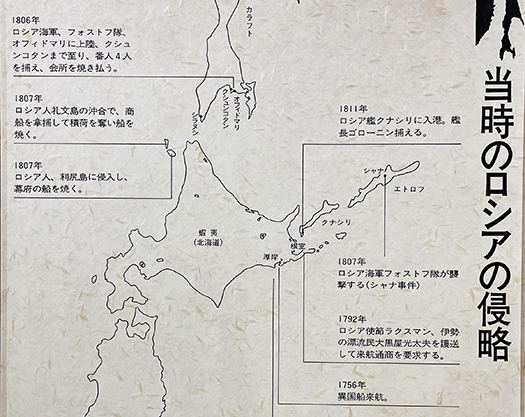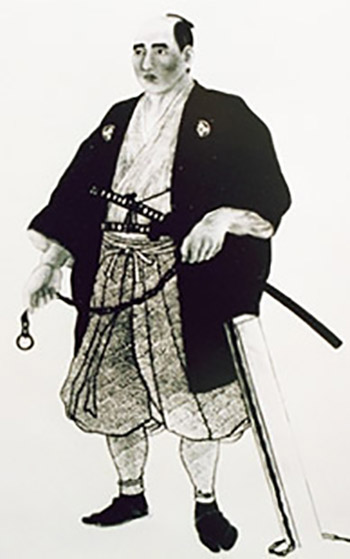


間宮林蔵と言ってもイマドキの人にはそう「響かない」ようですね(笑)。まぁ当然でしょうか。間宮林蔵って誰さ?という反応が自然のようです。なので簡単な当時の世相の様子とかれ自身の幕府に出仕するまでの経歴・年表を以下に。
・1780年 常陸国筑波郡上平柳村の農家に生誕。家系は戦国期小田原の北条氏の家臣だった武家出自で秀吉の小田原攻めによってこの地に落ち延び,帰農したという。
・1787年(8歳)このころ寺子屋通いをはじめる
・1792年(13歳)筑波山に登り立身出世を祈願 村の海老原庄右衛門から算術を習う
・1795年(16歳)堰工事で当地出張中の幕府普請役下条吉之助に土木算術への才を見出される。
・1798年 近藤重蔵、最上徳内らエトロフに渡り「大日本恵登呂府」の標柱を建てる。
というような時代背景とかれ自身の経歴の概要。のちに北海道島・樺太島の測量探索に向かい今日にまで世界地図に名を残す「間宮海峡」を発見し、対ロシアの欧米世界的世論に対して日本人ここにありと強く存在感を示すことになる。
江戸期の幕府中枢では世界情勢に対し詳細な情勢把握が行われていたことが近年、あきらかにされてきている。幕府が開国を決断しその対手として独裁国家ロシアなどではなくアメリカを選択したのも、世界情勢への深い洞察を持っていたことを証すのだとされてきている。
基本的には英米を対話相手にしてロシアの侵略と戦わねばならないと正しく認識していた。後の日露戦争時の「日英同盟」に至る日本としての世界戦略。こうした国際認識に基づいて幕府は北海道島をもって日本国土防衛の最重要地域として外交と軍事戦略を練っていた。そういう中で幕府としては、民間から多くの有意な理工系人材のリクルート活動を行っていたと思える。
算術を基礎に勉学に勤しみ神童と評価が高かった間宮林蔵は、16歳でスカウトされて江戸に出仕し、国土北辺の緊張する対ロシア情勢の中に身を投じていく。
今日でもウクライナ侵略行為を平然と行う無法国家ロシアの危険性。この暴虐な覇権主義国家に対して日本人の国土防衛意識は高まっていった。間宮林蔵などの有為な民間人の登用というカタチで幕府は危機に対応していたといえる。当時の世界でも英米を中心とする国家群は、ロシアに対して危険視し、それをどう封じ込めるかに戦略的に対応していた。
日本が他のアジア国家とはまったく違う国際認識を持ち、厳しいロシアの軍事侵略姿勢に対して、より自由主義的な英米の側に自らの立場を確立していったことは、今日にまで通底している。
国防の基本は冷静な国土の冷徹な地理的把握。対ロシアとの戦いにおいて「地の利」を得ることが大前提なのだ。北海道島が対ロシアの日本防衛の最前線という戦略方針はま異存がない。
日本の戦略確立に果たした間宮林蔵たちの冷静な国土地調査活動。とくに大陸と樺太が陸続きではないということは、世界中がその事実を戦略立案の基礎とした。
故郷の地で神童と謳われた少年・間宮林蔵の胸中はいかなるものだったのか、興味深い。
English version⬇
National Defense Awareness of Russian Aggression Boils Over – Rinzo Mamiya’s Birthplace – 2
As the basic composition of the world, the Russian state has always been an invasion danger state. What is happening now in Ukraine was correctly recognized as a crisis more than 200 years ago. …
It seems that saying “Rinzo Mamiya” does not “resonate” so well with people of today’s generation (laughs). (Laughter) Well, is it any wonder? Who is Rinzo Mamiya? It seems to be a natural reaction. So, here is a brief history and chronology of Rinzo Mamiya’s career up to the time he served in the Shogunate.
Born in 1780 in a farmhouse in Kamihirayanagi Village, Tsukuba County, Hitachi Province. His family was a vassal of the Hojo clan in Odawara during the Warring States period, and he returned to farming after Hideyoshi’s invasion of Odawara.
In 1787 (age 8), he started going to a temple school.
1792 (age 13): Climbed Mt. Tsukuba to pray for success in life, and learned arithmetic from Ebihara Shoemon in the village.
1795 (Age 16) Shimojo Kichinosuke, a shogunate contractor, discovered his talent for civil engineering and arithmetic during a trip to the area to work on a weir.
In 1798, Kondo Shigezo, Mogami Tokunai, and others traveled to Etorofu and erected the “Dai Nihon Etorofu” marker.
This is an overview of the background of the period and his own career. Later, he went on a surveying expedition to Hokkaido Island and Sakhalin Island, and discovered the Mamiya Strait, which remains on world maps to this day, and strongly demonstrated to the Western world opinion against Russia that the Japanese were here to stay.
In recent years, it has become clear that the central government of the Edo period (1603-1867) had a detailed grasp of world affairs. The Shogunate’s decision to open the country to the outside world and to choose the U.S. over the dictatorship of Russia as a countermeasure is considered to be evidence of its deep insight into world affairs.
Basically, he correctly recognized that he had to fight against Russian aggression with Britain and the United States as dialogue partners. A global strategy as Japan that later led to the “Anglo-Japanese Alliance” during the Russo-Japanese War. Based on this international recognition, the Shogunate was developing diplomatic and military strategies for the defense of Japan’s land on the island of Hokkaido as the most important region. Under such circumstances, the Shogunate seems to have been recruiting many talented scientists and engineers from the private sector.
Rinzo Mamiya, who was highly regarded as a child prodigy for his studies in arithmetic, was scouted at the age of 16 and sent to Edo (Tokyo), where he threw himself into the tense situation in the northern part of Japan in relation to Russia.
The danger of Russia, a lawless nation that even today carries out acts of aggression against Ukraine with impunity. The Japanese people became increasingly aware of the need to defend their land against this tyrannical hegemonic state. The Shogunate responded to the crisis in the form of the appointment of talented civilians such as Rinzo Mamiya. At the time, the world’s nations, led by Britain and the U.S., viewed Russia as a danger and strategically responded to contain it.
The fact that Japan had a completely different international perception from other Asian nations and established its own position on the side of the more liberal Britain and the U.S. in response to Russia’s harsh military aggression stance is still prevalent today.
The basis of national defense is a calm and dispassionate geographical grasp of the country. Gaining a “geographical advantage” in the fight against Russia is a prerequisite. I have no objection to the strategic policy that Hokkaido Island is the front line of Japan’s defense against Russia.
The calm land survey activities of Mamiya Rinzo and his group played a key role in establishing Japan’s strategy. In particular, the fact that the continent and Sakhalin Island were not connected by land was used by the world as the basis for strategic planning.
It is interesting to see what was going through the mind of Rinzo Mamiya, a boy who was hailed as a child prodigy in his homeland.
Posted on 5月 16th, 2023 by 三木 奎吾
Filed under: 歴史探訪







コメントを投稿
「※誹謗中傷や、悪意のある書き込み、営利目的などのコメントを防ぐために、投稿された全てのコメントは一時的に保留されますのでご了承ください。」
You must be logged in to post a comment.